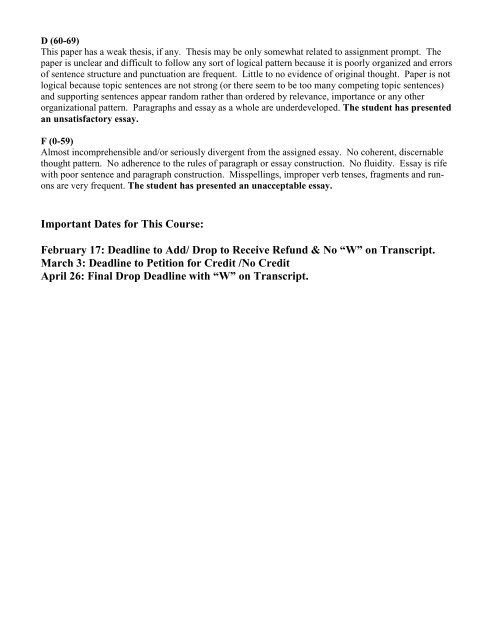Syllabus& Grades - Cuyamaca College
Syllabus& Grades - Cuyamaca College Syllabus& Grades - Cuyamaca College
participate in these discussions, may result in you being asked to leave the class and/or receiving anabsence for the day. Lastly, you must turn in your responses at the end of each discussion. In addition, wewill have a class novel that we will utilize critical thinking skills to conduct assignments, classdiscussions, and Literature CirclesFinal ExamThe Final will be in the form of an in-class essay and you are to bring a bluebook to the event as it isrequired for the examination. The examination prompt will be given on the assigned test date and youressay response should be approximately 3-5 pages in length. For the Final, the entire class time will beprovided to complete the examination.Contacts: One of the best resources in this class is the person sitting right next to you. By creating anetwork of contacts in this class, you will help you chances of success in the case of absence. In addition,friends you make in my class may follow you through the rest of your academic careers. You are urged tohave at least three names and phone numbers of other people in the class whom you can call forinformation.1.2.3.Grading Standards:A (90-100%)The paper follows all rules of good paragraph and essay construction. The paper has strong topicsentences, an original thesis, a strong, logical conclusion and relevant, appropriately used supportinginformation. Conclusion is logical, though inventive and does more than summarize the points appearingprior to it. The student expresses their thoughts in an unusually original, creative, significant or otherwiseexceptional way. Details are full and appropriately placed. The writer’s voice and ideas are very clear,even if they are in agreement with their subject or author at hand. Sentences are vividly clear, transitionsflow smoothly from one idea to another. Overall, the student has presented an excellent paper.B (80-89)The writer shows good competence in paragraph and essay construction. The thesis is easily identifiedand well-supported with only occasional inconsistency. Some subordinate ideas may be somewhatunclear. Word choice is occasionally awkward. The conclusion is relevant and supported by the evidencepresented earlier in the paper. Sentences are strong and generally grammatically correct, but notunusually detailed or creative. There may be a few small errors in logic, or one significant error in thelogic of the paper. There are a few errors in spelling, syntax and/or punctuation. Overall, the studenthas presented a good paper.C (70-79)Competent work which meets or slightly exceeds the minimum requirements of the assignment. Content,organization, thesis formation and supporting sentences are competent, but expression may be marred bysentence fragments, run-ons, misspellings and/or improper verb use. Writer’s ideas are somewhatapparent, but may be indistinguishable from their subject’s agreement or disagreement on an issue.Thesis is present, but is not very strong or original. Transitions between sections are present, but notsmooth. The student has presented an acceptable essay.
D (60-69)This paper has a weak thesis, if any. Thesis may be only somewhat related to assignment prompt. Thepaper is unclear and difficult to follow any sort of logical pattern because it is poorly organized and errorsof sentence structure and punctuation are frequent. Little to no evidence of original thought. Paper is notlogical because topic sentences are not strong (or there seem to be too many competing topic sentences)and supporting sentences appear random rather than ordered by relevance, importance or any otherorganizational pattern. Paragraphs and essay as a whole are underdeveloped. The student has presentedan unsatisfactory essay.F (0-59)Almost incomprehensible and/or seriously divergent from the assigned essay. No coherent, discernablethought pattern. No adherence to the rules of paragraph or essay construction. No fluidity. Essay is rifewith poor sentence and paragraph construction. Misspellings, improper verb tenses, fragments and runonsare very frequent. The student has presented an unacceptable essay.Important Dates for This Course:February 17: Deadline to Add/ Drop to Receive Refund & No “W” on Transcript.March 3: Deadline to Petition for Credit /No CreditApril 26: Final Drop Deadline with “W” on Transcript.
D (60-69)This paper has a weak thesis, if any. Thesis may be only somewhat related to assignment prompt. Thepaper is unclear and difficult to follow any sort of logical pattern because it is poorly organized and errorsof sentence structure and punctuation are frequent. Little to no evidence of original thought. Paper is notlogical because topic sentences are not strong (or there seem to be too many competing topic sentences)and supporting sentences appear random rather than ordered by relevance, importance or any otherorganizational pattern. Paragraphs and essay as a whole are underdeveloped. The student has presentedan unsatisfactory essay.F (0-59)Almost incomprehensible and/or seriously divergent from the assigned essay. No coherent, discernablethought pattern. No adherence to the rules of paragraph or essay construction. No fluidity. Essay is rifewith poor sentence and paragraph construction. Misspellings, improper verb tenses, fragments and runonsare very frequent. The student has presented an unacceptable essay.Important Dates for This Course:February 17: Deadline to Add/ Drop to Receive Refund & No “W” on Transcript.March 3: Deadline to Petition for Credit /No CreditApril 26: Final Drop Deadline with “W” on Transcript.



